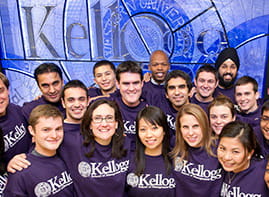Speakers and panelists discuss the future of public and private exchanges at this year’s MacEachern Symposium
5/27/2016 -
Faculty, alumni, students, and healthcare industry experts discussed the challenges facing the public and private exchange systems at the
2016 Malcolm MacEachern Symposium at the Allen Center.
An annual event at Kellogg, this year’s symposium, entitled “Public and Private Exchanges: What Does the Future Hold,” was hosted by the Health Enterprise Management Program and delved into many of the issues surrounding the exchange system. From public exchange customers choosing ill-fitting healthcare plans to the shift in health insurance consumerism as private exchanges move toward a more employee-centric model, it was a topic ripe for discussion.
“Convening discussions between industry leaders and academics is a central mission of a leading business school,” says
Leemore Dafny, the Herman Smith Research Professor in Hospital and Health Services and a professor of strategy at Kellogg. “We want to ensure our research and frameworks are useful in practice, and we want input from industry on what questions are mission-critical and unanswered to date. “
Concerns about the future of exchanges have become more pertinent as the number of public exchanges continues to grow, taking up a bigger share of the market since the Patient Protection and Affordable Care Act (ACA) was passed in 2010. Nearly 20 million more people have health coverage as a result of the ACA since enrollment began in 2014, with 12.7 million joining via public (federal and state-based) exchanges in 2016, according to a recent report from the Washington, D.C.-based Kaiser Family Foundation.
This has led to a rise in private exchanges — marketplaces where employers can shop for insurance plans and policies for their employees. More than 8 million people are enrolled in coverage through private exchanges, up from 6 million in 2015, according to an Accenture report.
“The future of our healthcare system is tied to the exchanges,” says
David Dranove, the Walter McNerney Distinguished Professor of Health Industry Management at Kellogg, stressing that the industry will not improve until issues surrounding the two exchange systems are resolved.
Adverse selection a key issue
One of the biggest challenges facing the public exchange system according to keynote speaker Dr. Jonathan Gruber, Ford Professor of Economics at Massachusetts Institute of Technology, is “adverse selection,” a phenomenon that occurs when healthy people switch to more affordable insurance plans when their premiums rise, while those with more serious or persistent health issues remain on the richer plans. As a result, the members who remain on the richer plan experience exorbitant premium hikes in order to offset the unhealthier group’s rising medical costs.
On top of that, Gruber said, research shows that seniors do a poor job of choosing their Medicare plans.
Drawing from his past experience developing Massachusetts’s healthcare reform in the mid-2000s and consulting on what would later become the ACA, Gruber argued that the industry needs better choice architecture, meaning changes to the way healthcare choices are presented to consumers, and better decision support for the exchanges to grow while keeping costs down.
Policymakers are working on these challenges, and Gruber says he has confidence that they will be resolved in the future.
Employees want control
Switching to private exchanges, keynote speaker Ashok Subramanian, CEO and Co-Founder of
Liazon, a private benefit exchange company based in New York, discussed the shift in private exchange systems from being employer- to employee-centric.
For decades, employers have offered healthcare benefits to employees based a defined benefits model: The company offers a standard set of health benefits while shouldering most of the cost.
In the last decade, as healthcare costs have soared, companies began moving toward private exchanges. Though analogous to the public system, in a private healthcare insurance exchange, employers rather than individuals shop and offer a broad choice of health and ancillary products to employees, who then choose which products they want,
Private exchanges continue to rise in popularity. Subramanian referred to a recent employee survey conducted by Liazon in which 95 percent of employees said they prefer to choose their own policies, with their companies offering assistance via educational materials, if necessary.
Subramanian said he believes private exchanges are here to stay, and only by focusing on the consumer experience and engagement will both employees and employers come away satisfied.
“Healthcare is an emotional topic with a deeply rooted status quo, so change takes time,” said Subramanian. “Exchange operators need to do a better job of targeting those segments most likely to move [to an exchange].”
Choices and challenges
Now in its 33rd year, the symposium also included two panel discussions that explored insights and reactions from insurers and a look ahead at the future of exchanges.
“The future of public exchanges is going to be a function of how well we do at getting more people to the market,” says
Craig Garthwaite, assistant professor of strategy. “If we continue to have a system where people get their insurance form their employers, then the public exchange system will continue to be a challenging environment for us.”
As for the private exchanges, “if we’re going to keep offering [health care] through employers, what’s the most effective way to do that?” asks Garthwaite. “Employees may be better off in the private exchanges if they get a better set of choices.”
Related reading






